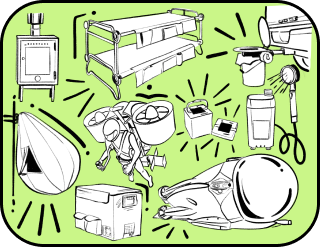How to make the Cheshire Cat disappear first, then teleport back
One day, a renowned professor from the University of Birmingham entered the lecture hall, holding a copy of Lewis Carroll’s “Alice in Wonderland”.
“The tip of his tail disappeared first, and lastly his grin; it lingered in the air long after everything else had vanished. — Well! — thought Alice. — I’ve seen cats without a grin, but a grin without a cat! That’s the most curious thing I’ve ever seen!” – read the professor and then declared:
“Now prove to me that what’s written in this story is impossible.”
The students immediately set to work on this unusual assignment, for it’s not every day one gets to argue with the classics of world literature and refute the existence of the Cheshire Cat.
Some students solved the problem quickly, while others are still working on it.
We recommend you try to solve the Cheshire Cat problem, first based on an unusual life scenario, then on an incredibly technological solution.
The first group of students based their argument on the fact that the Cheshire Cat cannot exist separately from its smile, just as it cannot appear in different places simultaneously, showing its tail or head to someone. The students rightly appealed to the many highly publicized examples of teleportation, which in reality turned out to be hoaxes.
Teleportation, from the Greek “far” and the Latin “to carry,” is the instant movement of an object to any distance faster than the speed of light. This term was introduced into usage by the American journalist and researcher of the “unexplained,” Charles Hoy Fort, after the publication in 1931 of the book “Volcanoes of the Sky” about parapsychology and the supernatural. However, at that time, this concept had little to do with science.
To convince the professor that teleportation is impossible, the students decided to refer to the Philadelphia Experiment of 1943, conducted on the small ship “Eldridge.” The goal of the Philadelphia Experiment was to make the ship invisible to enemy detection. The mainstream press at the time reported that the experiment was a complete success, as the ship actually disappeared physically for a period of time and then reappeared. Not only did the military manage to “cloak” the ship from sight and radar, they allegedly dematerialized and even teleported it.
In fact, this experiment had nothing to do with teleportation because the military didn’t physically move the ship; they simply created an intense magnetic field around the ship, which could cause light or radar waves to refract or bend, similar to a mirage created by heated air on a summer day.
According to the experiment, at 09:00 on July 22, 1943, the generators on the ship were powered on, and powerful electromagnetic fields began to build up. A greenish mist slowly enveloped the ship, concealing it from view. Elite Navy officers and participating scientists looked on with awe at their greatest achievement: the ship and its crew were invisible not only to radar but also to the naked eye! About fifteen minutes later, the generators were turned off, the greenish mist reappeared, and the “Eldridge” began to dematerialize as the mist subsided.
To conduct a similar experiment and solve the task set by the professor, the students of Birmingham University didn’t even need to use generators with a power of 75 kVA.
It was enough to hide the cat in the auditorium beforehand, convince everyone that the cat was in the corridor, then use illusion and blindfold the students along with the professor, just as oncoming cars blind each other with headlights at night. As the light leveled out, the cat began to appear. First, its head showed, then its tail, and then the fluffy creature itself emerged in all its glory.
Regarding the professor’s evaluation of the cat experiment, the University of Birmingham students tactfully remained silent.

Another group of students relied on the fact that physicists have long discovered that some particles can exist without their properties, and some properties can exist without particles. It sounds quite absurd, of course. Can you hear a voice without a person or the clap of one hand without the other?
But quantum physics isn’t surprised by such contradictions—particles can exist in different places simultaneously or spin both clockwise and counterclockwise at the same time. The rock star of the quantum world is Schrödinger’s Cat, who is both alive and dead. In this regard, the Cheshire Cat was luckier—they simply divided it from its smile.
If we were to find a fantastic analogy, quantum teleportation is more akin to telepathy. To understand how it works, imagine in a fantastical version of our world, children are born with a mysterious connection between them. When one is awakened, the other immediately opens their eyes—and if one’s pupils always look upwards, then the other’s pupils will look downwards (and vice versa). However, we cannot know in advance where their pupils are looking until we awaken them. The crucial point is that such a trick can only be performed once.
Physicists would say that the children are in a state of quantum entanglement. It would be inaccurate to say they are exchanging information. Simply put, if someone affects one child, both react. And this works at any distance. Teleportation is a way to instantly transmit the state of one child to another.
In the case of quantum particles, we interact with them—such as measuring spin (the so-called angular momentum)—and always get opposite states. For example, one particle’s spin will be up, and the other’s will be down. By manipulating entanglement, we can instantly transfer the state of one particle to another. The “recipient” and “donor” can be located at opposite ends of the galaxy.
In 2013, Yakir Aharonov proposed splitting neutron beams of one object using a cleverly designed measurement device and sending them along two different paths. Weak measurements of the device checked the particle’s position and its magnetic moment. Neutrons played the role of the Cheshire Cat, and their spin represented its smile. After the neutrons and their pulses passed through the measurement device, they were separated, with the neutrons going their own way, separate from their pulses, much like if your car drove on one road while its speed traveled on another.
In 2017, Chinese scientists successfully teleported photon parameters through a satellite between two Earth-based laboratories separated by 1200 km. Other scientists from the University of Leicester calculated that the digitized data of all cells in the human body would amount to an astronomical volume—2.6×10 to the power of 42 bits. By technical standards, transmitting such data would take up to 4.85×10 to the power of 15 years, far exceeding the age of the Universe. And where would one store such a volume of data required for teleporting an object? Would the digital duplicate of the object or person be identical to the original? What about consciousness and other complex processes whose nature we don’t even understand?
The group of students from South Africa, Germany, and Spain, as reported in the article, decided to utilize these discoveries to convince their professor that object teleportation is possible. Last December, they conducted an experiment where they were able to teleport information using quantum entangled photons and a nonlinear detector.
They managed to “pack” all the information about the transmitted object into two entangled photons. Then, this data was successfully teleported from one point to another. In this case, photons served not only as guarantors of data fidelity but also as means of encryption and transmission. This method of data encoding significantly increased the number of parameters that can be teleported in a quantum state and transmitted a whole set of indicators.
The students admitted that currently, the transmitted data is only sufficient for a few pixels, but in theory, nothing is stopping humanity from quantum teleportation of entire images or small files.
During their experiments, the scientist-students often recalled the wise sayings of the Cheshire Cat and believed that someday the character from the fairy tale would be able to teleport into the human world, flashing its smile here and there.

Your thought is a big bang of ideas. Our journal is its source.
Thank you!




